
Friday March 17, 2006
NINCO Triple Threat!
Renault Clio VS Mitsubishi
Lancer
New N-Tronic Control!
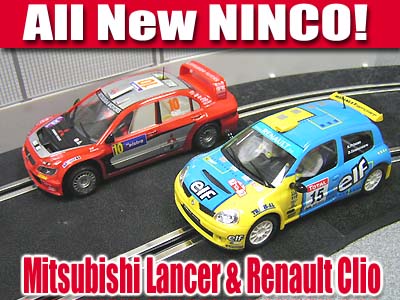 If
one thing can be said about the Rally series of models in our hobby, it is that
NINCO is very enthusiastic about it. They have brought us many different models
in the past and it seems they are intent to bring us even more. The very latest
from them may represent the series in the same way, but that similarity ends
when we decide to give them a closer look. We also have a nice surprise with
another new item in the NINCO line that just might make piloting these models
even better.
If
one thing can be said about the Rally series of models in our hobby, it is that
NINCO is very enthusiastic about it. They have brought us many different models
in the past and it seems they are intent to bring us even more. The very latest
from them may represent the series in the same way, but that similarity ends
when we decide to give them a closer look. We also have a nice surprise with
another new item in the NINCO line that just might make piloting these models
even better.
Both the Renault and Mitsubishi are not new models to the line but they are a new livery. Although Rally is not my personal favorite in this hobby, they are still very fun slot cars to race and I was glad to see NINCO add more to the series with these choices.
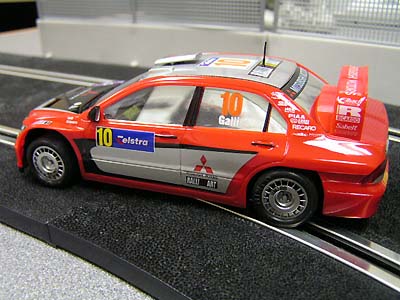
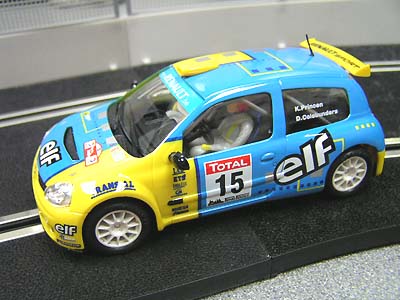
Overall fit and finish of both samples were excellent. These cars really caught my eye as the Tampo stampings and details just make you look even closer. All the markings seemed very accurate and most were sealed with a clean and dirt-free clear-coat. NINCO has come along way in the finish level department over the years and since they began to improve on this, I feel they have really increased the enthusiasm for most hobbyists in this scale.
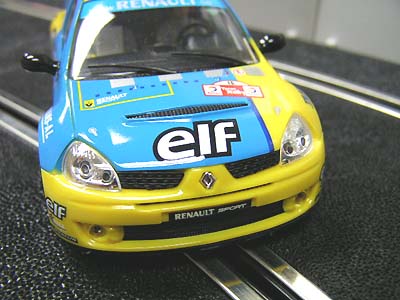
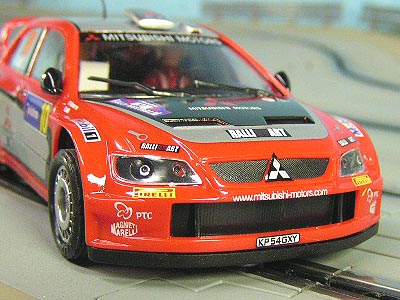
Body shape seemed accurate enough and looking at prototype photos shows that they have done a decent job re-creating them for us. One thing about these models is the level of detail in the interiors that seems to draw you in even closer.
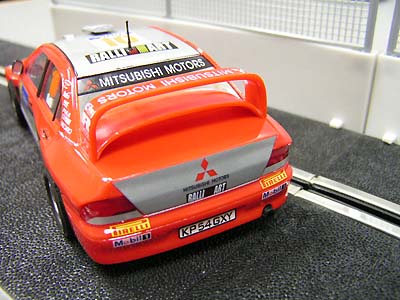
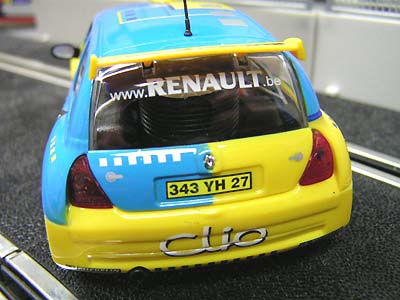
Both driver and co-driver are present along with roll cage detail, fire bottle and in some cases the spare tire. Even our co-driver can be seen holding on to the driving chart. The chrome tinted finish on the windows of the Mitsubishi is also an eye catcher and I liked the effort NINCO made with them.
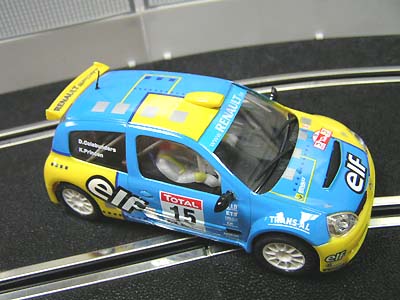
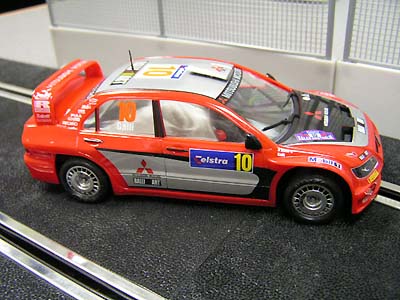
Wheels and tires on both models are standard NINCO fare with small ribs for the tread pattern and a medium to soft compound. All the wheels were very round and true and the tires needed minimal sanding to get them where I liked them. Some enthusiasts immediately replace these tires with after-market silicones for better performance, but I am going to leave the standard rubber in place for these tests.
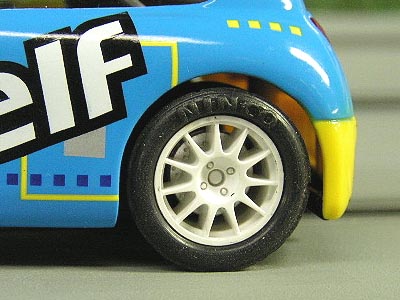
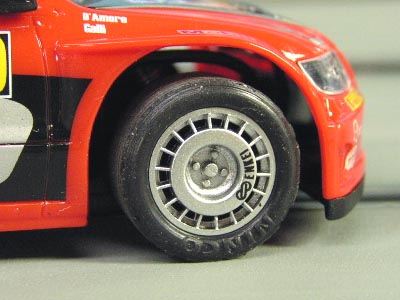
Turning the models over we see that both are equipped with the 20,000 RPM NC-5 Speeder motor in the inline configuration. We also see the NINCO standard button magnet in place near the center of the chassis. So far things appear pretty even on these models but it was time to go inside and see what differences there were.
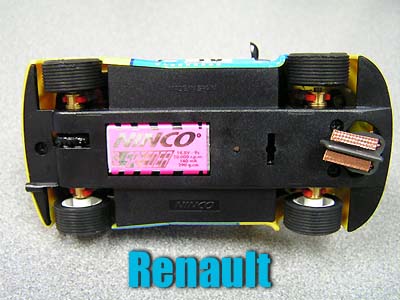
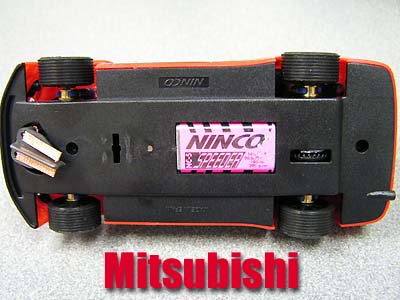
The Renault has 3 chassis screws while the Mitsubishi has only 2. After removing them we finally see what sets these 2 models apart. The Renault is standard 2 wheel drive while the Mitsubishi is 4 wheel drive.
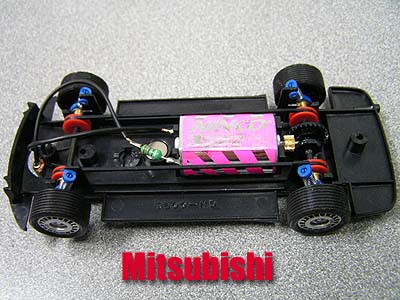
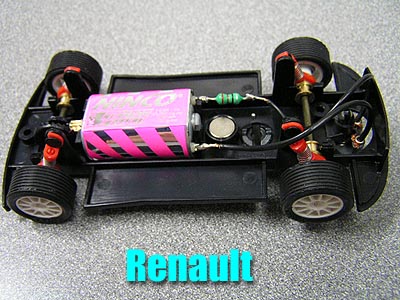
The dual pulley system is durable enough and it does work as intended. We also see both models equipped with the Pro-Shock suspension but the Renault is outfitted with the Red (Soft Action) shocks while the Mitsubishi has the Blue (Medium Action) installed. Both models have the same gearing of a 9 tooth pinion and 27 tooth crown gear.
Match-Up Time
The first tests I ran was a surprise because I thought the Clio would out pace the Mitsubishi given it was not using as much power draw and that the shorter and lower model would handle better in the corners.
However, the Mitsubishi was clearly a dominant model with a lap time average of 4.6 seconds while the Clio was well behind with a 4.9. Was the 4 wheel drive actually helping the Mitsubishi this much in the corners? Something certainly was as I could just feel the Mitsubishi had more stability and would hold the corners better.
I then decided to disconnect the 4WD system by removing the belts. I went back to the track and the Mitsubishi did suffer from removing it. My averages were now in 4.8 second range, still ahead of the Clio but it was obvious it was still the dominant car for today. I like both models but I preferred the overall looks of the Clio. There is just something about this small little hot rod that appeals to me and perhaps the small size is one of them. Of course one could tune these models further to make them a closer match, but the longer wheelbase on the Mitsubishi seems to give it the edge on our tighter layout.
New Control!
While working on this review I received another package from MRC and inside was an item many NINCO and other enthusiasts have been waiting for. The new N-Tronic electronic controller by NINCO had finally arrived and what better time to test it than right now with 2 of the very latest NINCO releases?
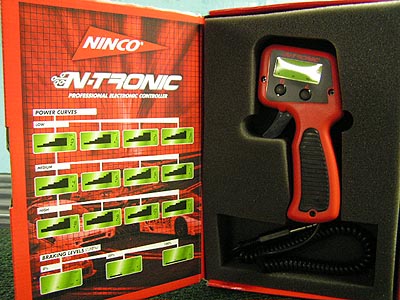
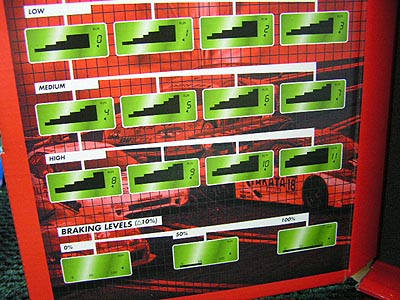
Opening the box you immediately see a chart showing you 3 different power curves and braking levels. I must admit, I was a little confused about just what these charts meant. The braking seemed easy enough as it shows you the meter and what percentage your braking feature was set at. But the Power Curve chart had me thinking out loud for a few seconds.
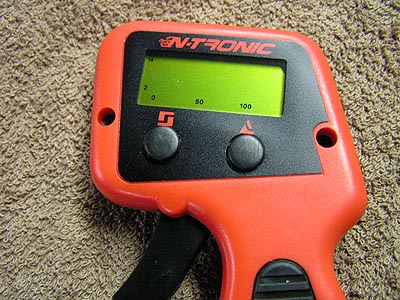
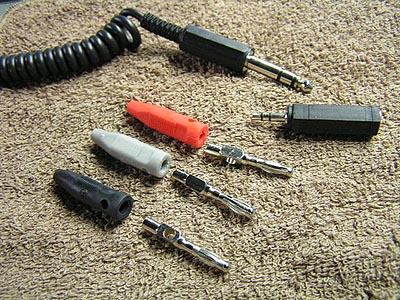
Inside is the controller, a small instruction booklet and adaptors that allow you change the controller ends to match different power base configurations. By biggest surprise was NINCO has included 3 banana plug connectors for use. The instruction booklet tells you what wires go where so those who want to use this option should find it easy.
I hooked our controller up to the NINCO test track and followed the instructions. The Power levels soon became very clear as it mostly a matter of RPMs. On the lowest setting your max speed and power is greatly reduced while the highest setting of 11 has full power and speed. The button on the right is also a the "turbo" boost option so that while you are racing, pressing and holding it down simply brings up to max controller speed.
Operation is pretty straight forward and both our models ran very well with this new control. The Mitsubishi was still the king of course, but the level of control I now had made driving them a little easier. I found that I liked a setting of 6 on our smaller layout as it gave me a little more cushion in the trigger control. On 11, barely pulling the trigger has you launching at almost max speed and would be best suited for larger, broader radius environments.
The braking adjustment is a nice feature as well. Changing the percentage does effect how crisp the braking action is and many racers should find it valuable in the tuning process for different layouts.
Conclusions
The N-Tronic controller is a nice addition to the NINCO line and it functions as intended. However, I have to say that with a retail price of $79.98 it might be more than the average enthusiast is willing to spend. If you are one of those enthusiasts who are very brand loyal and you only want NINCO products with your NINCO track, then this controller might be worth the investment.
Both the Mitsubishi and Renault are fine models and are fine additions to the NINCO line. The NC-5 motor is powerful and on smaller layouts can make driving a handful, but you can always change motors to suit these conditions. Again, at a retail price of $55.98 racers on a tight budget might pass on these models, but for the ones who do choose them I think they will find 2 very nice slot cars in this series.
- Harry
As always feel free to contact me about this article or just the hobby in general at harry@homeracingworld.com, or better yet drop into our Message Forum and share your thoughts with other enthusiasts!
Thanks Go To MRC For Providing Us With These Samples!